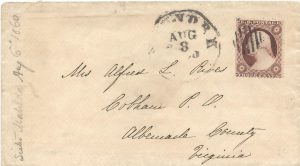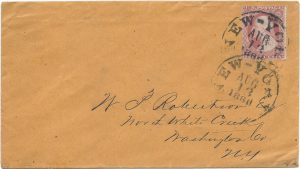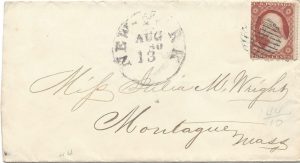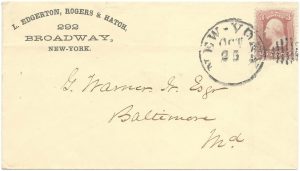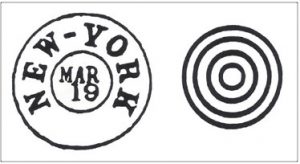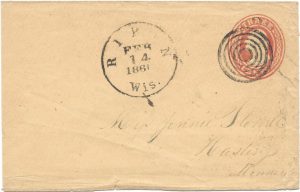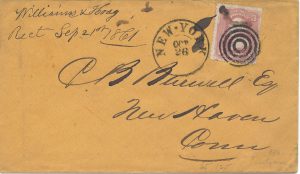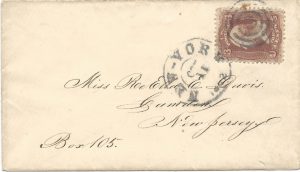By Ardy Callender
In the years prior to 1860, the New York City post office (NYPO), as well as most post offices in the United States, had been canceling domestic mail almost exclusively by date stamp. This method proved unsatisfactory as the date stamp did not adequately cancel the adhesive and was often illegible. The U.S. Post Office Department (USPOD) grew increasingly concerned over the reuse of lightly canceled stamps and on July 23, 1860 Postmaster-General Joseph Holt issued a supplemental regulation prohibiting the use of date or “rate” stamps to cancel adhesives.
General John A. Dix, the New York City postmaster at the time, recognized the new regulation would double the amount of time and work necessary to process the mail. Early the following month, Dix came up with the idea of combining the date stamp with the obliterator to make a single instrument that could accomplish both tasks in one stroke. Dix contacted his hand stamp maker, Edmund Hoole, to produce a “duplex” handstamp by attaching a “blotter” to the side of a regular handstamp. Hoole provided a number of devices which were first used in NYPO’s domestic department on August 8, 1860, as seen in Figure 1. For a few weeks after the introduction of the new duplex, un-duplexed cancellations continued to be used including adhesives cancelled solely by the date stamp (Figure 2) and a mix of un-duplexed date stamps with various types of grids (Figure 3).
The date stamp portion of the new duplex consisted of the “old design” large 33mm circular date stamp previously employed by the department throughout the 1850s. The “blotter” or cancelling element was a small seven-bar grid which varied in size and shape — the outline of the grids ranged from round to more elliptical. Although sometimes lacking, most devices included the year date within the date stamp. It is reasonable to assume the “blotter” element was composed of some type of metal — as a durable, long-lasting obliterator was required for the large volume of mail handled by the NYPO.
The latest known use of New York’s first duplex as recorded by the author is shown here as Figure 4. The cover is franked by a 3¢ rose pink variety of the 1861-1866 Regular Issue. Dated October 25, the date stamp and oval shaped obliterator tie the stamp at the bottom. Although the date stamp is not year-dated, a year of 1861 can be established as a cover mailed a year earlier in October, 1860 would be franked with a 3¢ 1857-1861 Issue adhesive and as to be discussed below, a totally different duplex device was employed in October, 1862. Both pink and rose-pink varieties occur primarily in the mid-1861 period as well as the rose and dull red stamps which later became the workhorse of the 1861-1866 Issue.
In late 1861, a new design of duplex was introduced in the NYPO domestic department. It consisted of a four-ring target duplexed to a 25 mm double ring date stamp, seen in Figure 5. The device was probably manufactured by Edmund Hoole as he held the USPOD contract at the time (1859-1863) for providing postmarking devices to first class U.S. cities eligible for governmental postmarks. The target “killer” became one of the most common cancellations used by other cities into the 1880s.
New York City appears to have been the first to duplex the target with the date stamp. Earlier in the 1860s, smaller post offices had began utilizing targets as obliterators. These targets however were not duplexed with date stamps but were simplex devices. The simplex example shown here as Figure 6 exhibits wide spacing between the target and the date stamp indicating two devices were employed. Dated February 14, 1861, the reduced Nesbitt postal entire was sent from Ripon, Wisconsin. The date stamp is of the old 32mm style used during the 1850s. The target is larger than NYPO’s marking and possesses five rings instead of New York’s four.
The target duplex was in use by NYPO’s domestic department for approximately a year. Originally, the date stamp included simply month and day annotations. However, sometime in June 1862 a year date was added, centered at the bottom between the two rings. Accordingly, covers dated prior to June 1862 are difficult to date unless docketed or containing correspondence.
The earliest example of a New York target duplex recorded by the author is October 26, 1861, shown in Figure 7. Although the postmark is not year dated, the cover is docketed at the upper left in 1861. Often the inner ring of the date stamp appears missing or absent but is a result of a being poorly struck. The cover in Figure 7 appears to be missing the inner ring but a small portion is visible above the “Oct” date slug. The cover’s docket states “Williams & Hoag, Rect Sep 21st 1861.” It is unclear why the docket is dated some five weeks prior to the date stamp although it may be a reference to previous business correspondence.
Like New York City’s 33mm with attached “blotter” device, the target duplex was fashioned out of metal (iron or brass). One of the issues with metal devices was that ink does not adhere adequately to the metal, resulting in light or weak strikes. For this reason, New York’s target duplexes were abandoned in late October 1862. The latest example recorded by the author is October 11, 1862, seen in Figure 8. The 3¢ 1861-1866 Regular Issue adhesive was applied sideways and tied by both the 4-ring target and date stamp.
The cancellation which replaced the target duplex was discussed in a previous NEWS article by the author in 2016.1 The onset of the Civil War produced a shortage of hard money (coins), and on July 17, 1862, President Lincoln signed a Bill which the public believed monetized postage stamps — stamps were now currency. The result was a great effort by many people to wash and reuse stamps with light cancellations. On October 9, 1862, Abraham Wakeman, the postmaster of New York at the time, responded with a new cancellation that actually cut into the surface (and sometime the contents of letters) of the adhesive. Known as “cutters”, these devices were employed for about a month, and later replaced with a duplex device with a cork or boxwood canceling element — the earliest recorded by the author is October 27, 1862. Cork and boxwood obliterators absorbed more ink and did a better job “killing” the adhesives and preventing reuse of the stamps.
Anyone with earlier examples of target duplexes from any post office (prior to October 26, 1861) is asked to contact the author through the USCC NEWS editor.
Endnotes:
- Callender, Ardy, “An Examination of the New York City ‘Cutter’ Cancellations and a New Find,” U.S. Cancellation Club NEWS, Whole No. 300 (August 2016), pp. 41-51.


